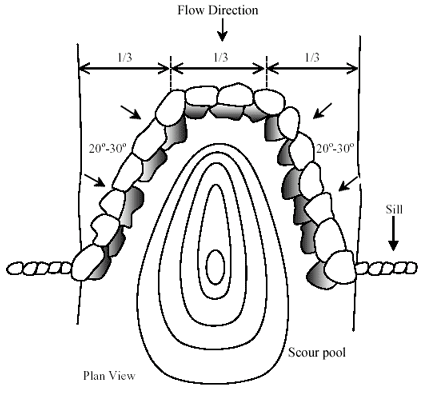Structures were installed in Seven Mile Creek to create
deeper pools and reduce streambank erosion.
Cross Vane
A cross vane is made up of a set of upstream angled lines of boulders,
connected by a section of smaller rocks upstream. While water usually
covers the shorter section during normal flows, the taller sections deflect
flow away from the banks of the stream. Flow is diverted over the rock
walls and concentrated down the center of the channel. The scouring associated
with high flow velocities in the center of the channel and the "waterfalling"
over the structure itself creates a deep, elongated pool.

J-Hook Vane
A J-hook vane is an upstream pointing line of rocks that originates at
one bank and terminates somewhere in the middle of the stream. The most
upstream portion of the structure bends back on itself, like a "J,"
curving into the middle of the channel. This bent portion serves to concentrate
flow and scour out a pool while the length closer to the shore deflects
flow away from the bank.
Where
a cross vane incorporates two structures on opposite banks cooperating
to control flow, J-hook vanes are often constructed in series on the same
bank. This technique was implemented in the Seven Mile Creek rehabilitation
project to protect a bridge embankment from being eroded.

Willows
Willows are planted on the creek bank to reduce erosion and provide cover for fish. Their root structures hold together the soil of the stream bank, increasing its structural integrity. They grow very quickly and in dense patches, which hang over the water and offer shady cover.
*Diagrams from Rosgen, D.L. The Cross-Vane, W-Weir, and J-Hook Vane, Structures...Their Description, Design and Application for Stream Stabilization and River Restoration.
Text Courtesty of Marc Antiniro
tour map | 1 | 2 | 3 | 4 | 5 | 6 | 7 | 8 | 9 | 10 |
BNC home | mrbdc home | web site map |


